| A
musical instrument that you meet only rarely nowadays is the bagpipe -
the askomantoura.
|

|
| The
bagpipe, a member of the woodwind family, consists of
three main parts: the mouthpiece, the bag and the pipe. The pipe is the
most complicated part and consists of a wooden socket with two reeds and
the melody pipe.
|
| For
the mouthpiece or the blowpipe (fouskotari) a hollowed out bone is
generally used, as it is considerably stronger than wood.
|
| The
bag
(askos) is made out of the skin of a kid or a lamb. An animal of approximately 7 kilos is preferred, as it gives the best
size of the bag. The hairs are cut to the length of ½ cm to prevent the
bag from bursting. The hairs will also catch the moisture when you blow,
and thus prevent the wooden parts from being destroyed. Afterwards the holes
from three of the legs are sewn up, while the hole from the throat
and the fourth leg remain open for the wooden socket and the mouthpiece.
Then the reverse side is turned out.
|
| The
wooden socket, cut out of oleander or maple, is hollowed out in order to
make room for the two reeds (kalami). Any leaks that may occur
are sealed with beeswax.
|
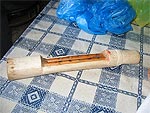
|
| The fingerholes
in the reeds are made by glowing pieces of wood in order to make them completely
round.
|
|
|
| The
reeds, which together make the melody pipe (mandoura), each consist
of two parts. Partly of the reeds, which are fastened in the
socket, and partly of two smaller reeds. A fine blade cut into
the smaller reeds creates the vibrations in the air-current and in that
way the sound of the instrument. The two smaller reeds are pressed into
the top of the socket and can easily be changed when the blade becomes worn.
|
| In
late summer of 2005 I visited the Omalos tableland - not the well-known
plain in Chania County, but the one that is located in the southern Lassithi
mountains, north east of Viannos.
|
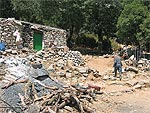 |
Here
I met Barba-Nikolis, who lives almost all summer in his mitato (herd's
hut), even if he could have retired long ago. We sat in the shade of
the small church chatting and sharing a chilled cucumber. Among other
things he told me that he makes bagpipes. As I asked him to show me
how, we went to his mitato, and after an improvised meal Barba-Nikolis
set about showing me. |
|
|
| He
explained that the most important part are the blades, which must be
cut with great precision, as they create the sound. |
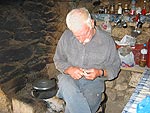
|
|
|
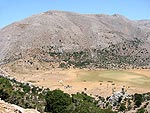 |
He
also showed me the wooden socket of the pipe, and while his adroit
fingers kept on cutting, he told how, as a young man, he used to climb the
mountain behind the mitato to collect his sheep that were grazing on the other
side. He had often been sitting on the mountain playing the
bagpipe or using it for signaling the other shepherds. The thought of
climbing the high mountain, and still having
enough air to play the bagpipe afterwards, left me virtually breathless. |
|
|
| As
Barba-Nikolis' bag was broken, and he did not have the time to make a
new one, he simply put the pipe to his mouth and started playing a mournful
melody. Indeed, the old shepherd still had enough air in his lungs. |
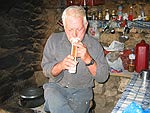
|
|
|
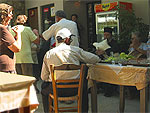 |
It
was a pleasant surprise when the next year I saw a priest
playing a bagpipe at a small party - this time on the well-known Omalos
plain. |
|
|
|
|
|
|
|
|
|
|